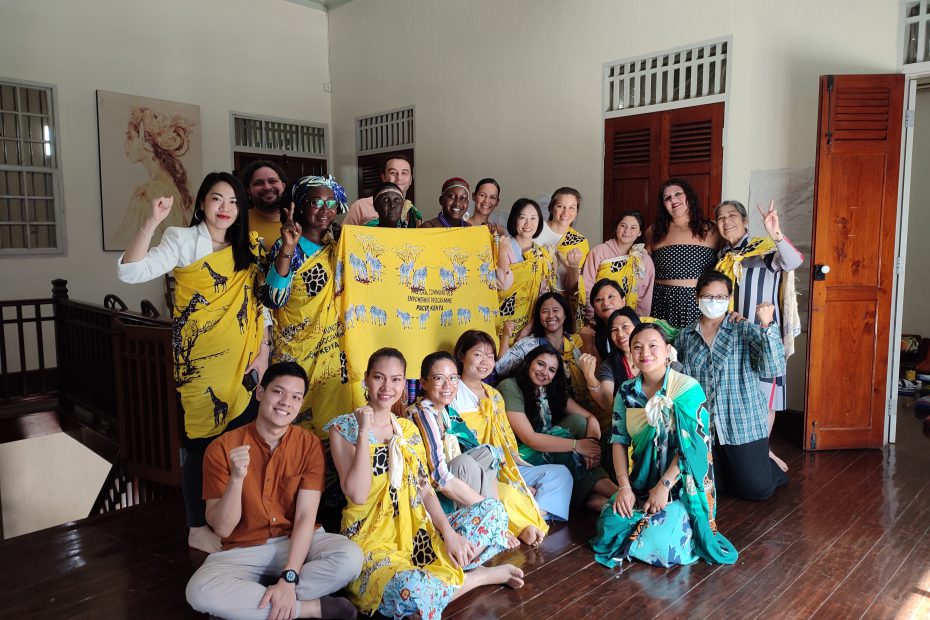Women4Biodiversity supports community-led restoration projects with a focus on strengthening gender-responsive approaches in ecosystem restoration in five countries with the recent addition of one more in Myanmar. Our work is guided by the Targets laid out in the Convention on Biological Diversity (CBD), where the preamble text recognizes the vital role that women play in the conservation and sustainable use of biodiversity, and affirms the need for the full participation of women in the implementation of the convention.
With the aim to strengthen gender-responsive ecosystem restoration approaches into national goals and international commitments through research and documentation of women-led ecosystem restoration initiatives in five pilot restoration sites, Women4Biodiversity conducted a 5-day workshop, from 15 May to 20 May 2023, in Chiang Mai, Thailand.
This workshop was organized by Women4Biodiversity with the support of Sida Funding through SwedBio at Stockholm Resilence Center at the Stockholm University.
The workshop brought together participants from 5 restoration countries – Argentina, Costa Rica, Cameroon, Kenya and the Solomon Islands who joined the workshop virtually. Taking on the opportunity of having the workshop in Thailand, Women4Biodiveristy also invited local partners NGOs — Inter Mountain Peoples Education and Culture in Thailand (IMPECT), Sustainable Development Foundation (SDF), and Karen Environmental and Social Action Network (KESAN) as well as youth members from Global Youth Biodiversity Network (GYBN) — Thailand Chapter. The workshop also provided two interpreters in French and Spanish.
The workshop was designed to build a strong network amongst the participants and to create an immersive experience to celebrate the role of women in biodiversity.
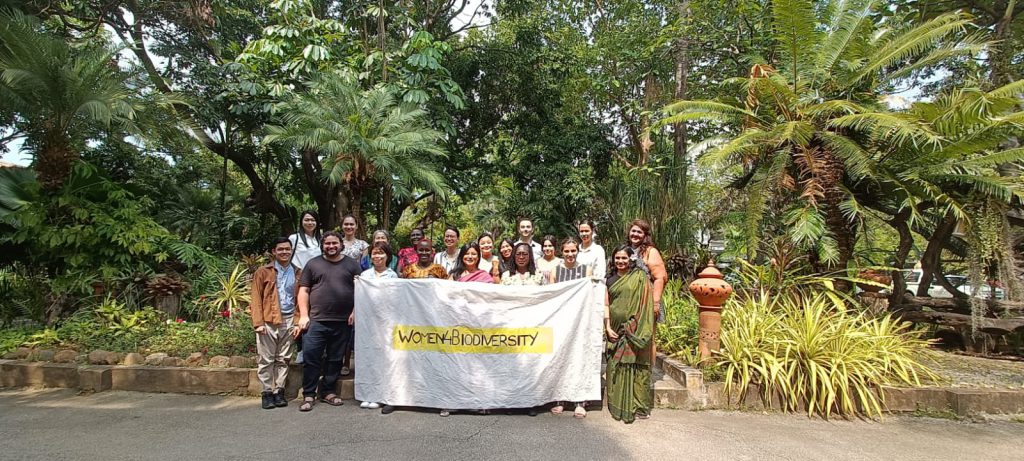
Summary of the workshop
The workshop began first with a ceremonial blessing by Noraeri Thungmueangthong, an indigenous woman from Huay E Khang village, a Karen village in Chiang Mai. She along with other women elders blessed the opening of the ceremony with prayers and blessing each of the participants by tying a holy thread on our wrists. Noraeri further expressed, “We need to protect the forest as it is the lifeline for many generations. We need to guarantee women’s equal rights and access to land so that the traditional knowledge and skills continue to pass down generation after generation.”
Following the ceremonial opening the day proceed with the introductions of the project by Shruti Ajit, Programme Officer for Women4Biodiversity. She explained the three-pronged approach that the project was focusing on — grassroots, dialogue and global processes.
- At the grassroots level, the project would focus on supporting and mobilizing communities towards restoration within their territories as well as building capacities to help document and create narratives towards the role of women in restoration.
- The dialogue process would include conducting legal reviews of National Biodiversity Strategy and Action Plans (NBSAPs) within the respective pilot restoration sites, dialogues with various stakeholders and related campaigns to identify and address gender knowledge gaps and best practices.
- In a global context, it would ensure supporting, enhancing and shaping policy narratives including international consultations and inputs to CBD processes in pursuit of gender-transformative plans and policies including active participation of communities in these processes.
The first day also saw an introduction from each restoration site on their initiatives, achievements, challenges and learnings. This was followed by a word association exercise on gender roles and expectations. The day ended with a discussion on Target 2 and its correlation with Target 22 and Target 23.
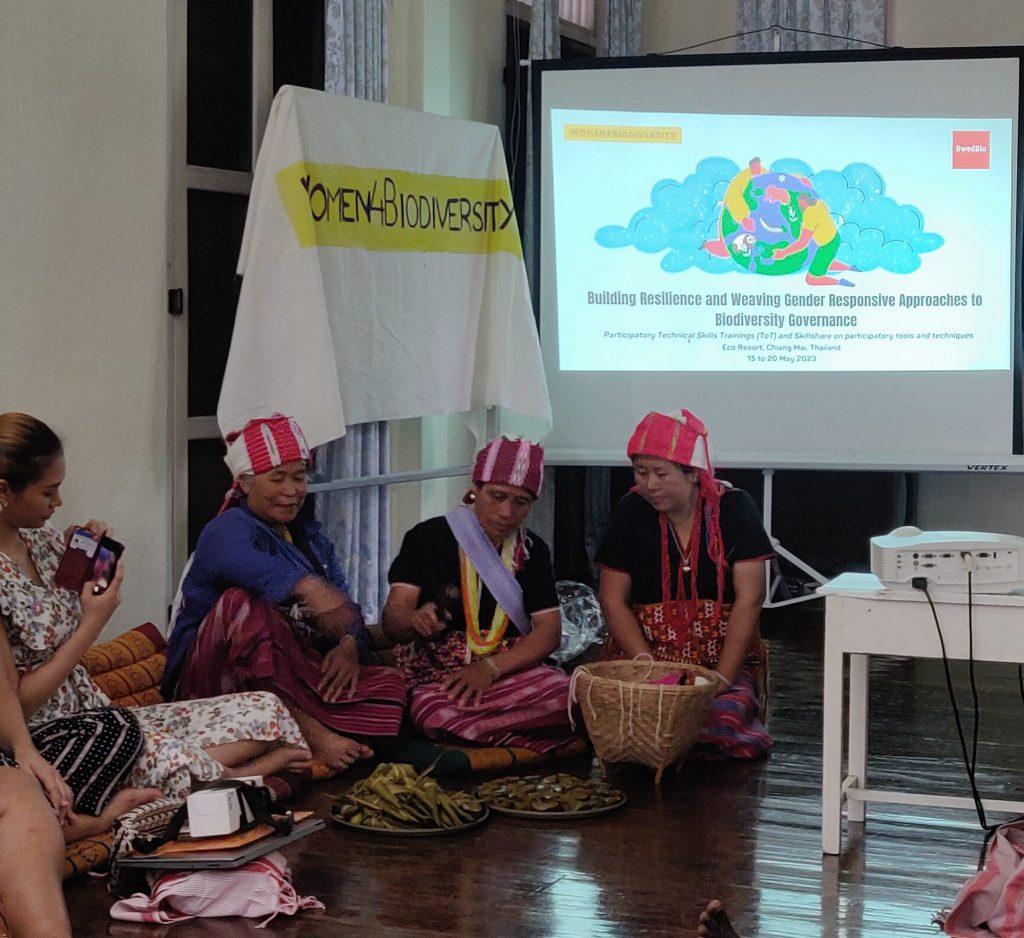
Day two was a mixed bag of topics ranging from introduction to NBSAPs, the need to protect biodiversity with a human rights approach, legal reviews by the restoration sites of their respective countries’ biodiversity laws, community mapping in Londji area in Cameroon, the role of youth in developing and monitoring NBSAPs in Thailand, and the process of free and prior informed consent (FPIC) in Costa Rica, and finally, a quick session on basic communication tools and tips that can help the pilot restoration sites. The day ended with a fun creative activity where everyone released their inner artists onto a canvas mural!
Day three started with a discussion on a communications assignment where participants had to form a pair to record a video of themselves stating what women want now that KMGBF had been adopted. The major part of the day was spent discussing practical work skills like timeline management and work plans. The day ended with a session on monitoring, evaluation and learning from SwedBio where guiding tools for better project monitoring were further discussed.
Day four was the last day of technical learning in the workshop. It started with the participants sharing intergenerational stories such as folk tales that they heard from their parents/grandparents. It came as a surprise to all participants that most of almost all of the stories told from various countries revolved around nature or elements of nature. Then the participants moved on to the River of Life exercise where they had to take time to reflect and draw a river with achievements and obstacles on either side of the banks towards a goal/objective that they see for themselves. It was a great exercise in storytelling and helped the group get to know each other better. This was followed by an interactive session on Alternative Transformation Framework, a format that provides a more in-depth understanding of alternative transformations on political, economic, social, cultural and ecological fronts. Towards the end of the day, all participants discussed ways to proactively document their restoration process/efforts, and the major takeaways from the previous days.
The day ended with a hybrid event celebrating the International Day for Biological Diversity (IDB) where the speakers stated the incomparable role of women in biodiversity conservation and restoration, intercrossing with other running themes like the challenges women face, and gender-responsive implementation of KMGBF. This event also brought together friends from Asia Indigenous Peoples Pact (AIPP).
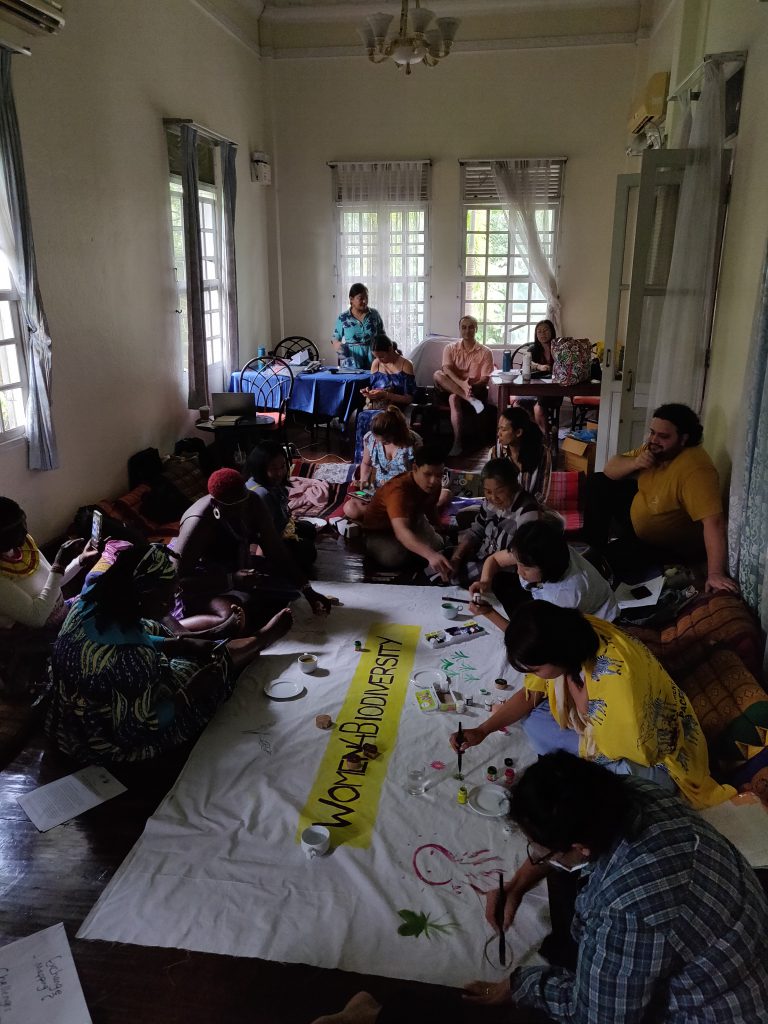
The workshop concluded on day five with a field trip to Huay E Khang, which is home to the Karen Community. This is also the community that Noraeri, the village chief, belongs to. We were greeted with cheerful smiles and a detailed explanation of their community forest mapping process and the challenges they encountered (and still encounter) in conserving their forest. After a warm meal, all of us participated in a tie-dyeing group activity. Turmeric, tree bark, and plants were used as natural dyes to create tie-dye handkerchiefs with no artificial colours used. After this interactive session, we all went for a walk in the community forest. The walk was not only refreshing but also educational as we learnt about many herbs and plants that had medicinal properties and ceremonial usage. However, the most interesting part about the field trip was how the community ties the umbilical cord of a newborn to a bamboo tree after birth — symbolizing the undying bond between the community members and the forest. Thus, creating an unbreakable vow and a continuous cycle of conservation. It walk was particularly interesting for participants from Kenya who work in the restoration of the Kamatira forest. Their curiosity was piqued by the uniqueness of the plants as well as the commonalities found with Kamatira.
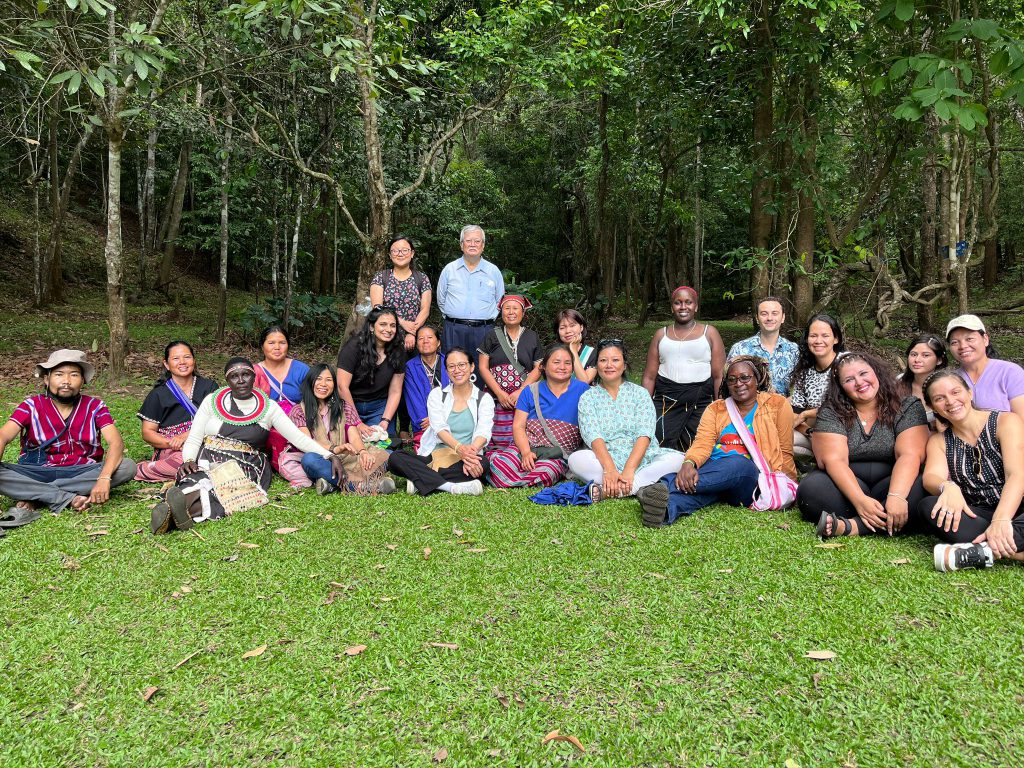
Conclusion
Some common threads that emerged out of the workshop were,
- Threats from climate change that all communities are reeling from, need to address issues of violence against women especially those who are defending and protecting their biodiversity.
- External threats like exclusionary conservation practices, inactive institutional structures and lack of information often impact the active participation of and neglected roles of women in conservation and restoration.
It allowed members from the restoration sites to come forth with their traditional indigenous knowledge, learnings and challenges, stories and ideas. It initiated a sense of community with each other despite the language barrier. When they arrived, they were participants but they returned home as friends and allies.
Even while dancing to energetic African tunes or a Thai lullaby during the creative song and dance breaks, there was one common feeling that united all of the participants — their strong will and resilience to rise above the challenges no matter how tough it gets. As they say, when the going gets tough, the tough get going.
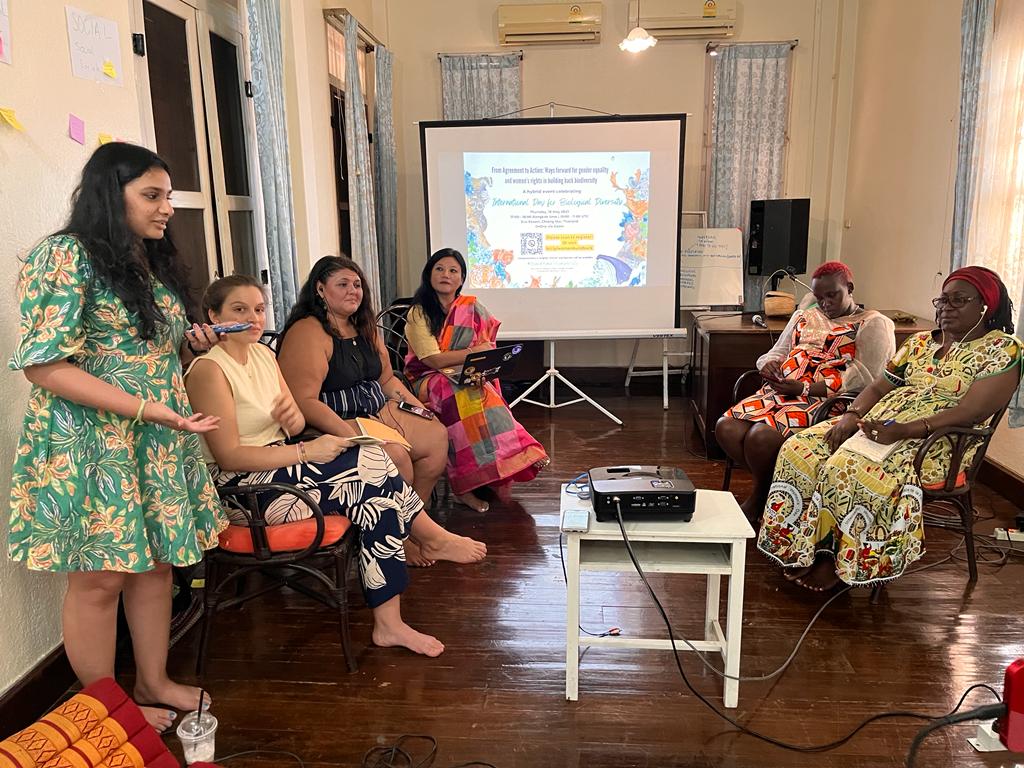
Left to right: Shruti Ajit (Women4Biodiversity), Valeria Enderle (CAUCE), Aracelly Jimenez (CoopeSolidar/Chomes), Mrinalini Rai (Women4Biodiversity), Priscah Chebet Liman (PACEP) and Rose Masso (REFACOF)
